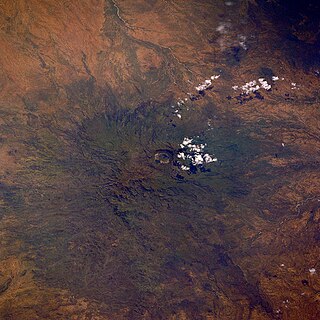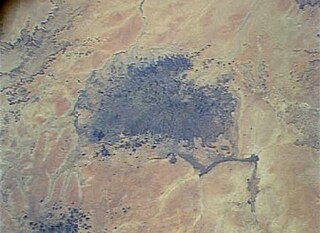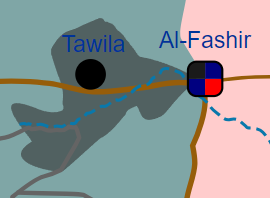
The Canadian Shield, also called the Laurentian Shield or the Laurentian Plateau, is a geologic shield, a large area of exposed Precambrian igneous and high-grade metamorphic rocks. It forms the North American Craton, the ancient geologic core of the North American continent. Glaciation has left the area with only a thin layer of soil, through which exposures of igneous bedrock resulting from its long volcanic history are frequently visible. As a deep, common, joined bedrock region in eastern and central Canada, the shield stretches north from the Great Lakes to the Arctic Ocean, covering over half of Canada and most of Greenland; it also extends south into the northern reaches of the continental United States.

Ethiopia is located in the Horn of Africa. It is bordered by Eritrea to the north, Djibouti and Somalia to the east, Sudan and South Sudan to the west, and Kenya to the south. Ethiopia has a high central plateau, the Abyssinian Highlands that varies from 1,290 to 3,000 m above sea level, with some 25 mountains whose peaks rise over 4,000 meters (13,200ft), the highest being Ras Dashen at 4,543 meters (14,538ft).

Emi Koussi is a high pyroclastic shield volcano that lies at the southeast end of the Tibesti Mountains in the central Sahara, in the northern Borkou Region of northern Chad. The highest mountain of the Sahara, the volcano is one of several in the Tibesti range, and reaches an elevation of 3,447 metres (11,309 ft), rising 3 km (1.9 mi) above the surrounding sandstone plains. The volcano is 60–70 kilometres (37–43 mi) wide and has a volume of 2,500 cubic kilometres (600 cu mi).

In geology and physical geography, a plateau, also called a high plain or a tableland, is an area of a highland consisting of flat terrain that is raised sharply above the surrounding area on at least one side. Often one or more sides have deep hills or escarpments. Plateaus can be formed by a number of processes, including upwelling of volcanic magma, extrusion of lava, and erosion by water and glaciers. Plateaus are classified according to their surrounding environment as intermontane, piedmont, or continental. A few plateaus may have a small flat top while others have wider ones.

Darfur is a region of western Sudan. Dār is an Arabic word meaning "home [of]" – the region was named Dardaju while ruled by the Daju, who migrated from Meroë c. 350 AD, and it was renamed Dartunjur when the Tunjur ruled the area. Darfur was an independent sultanate for several hundred years until 1874, when it fell to the Sudanese warlord Rabih az-Zubayr. The region was later invaded and incorporated into Sudan by Anglo-Egyptian forces in 1916. As an administrative region, Darfur is divided into five federal states: Central Darfur, East Darfur, North Darfur, South Darfur and West Darfur. Because of the War in Darfur between Sudanese government forces and the indigenous population, the region has been in a state of humanitarian emergency and genocide since 2003. The factors include religious and ethnic rivalry, and the rivalry between farmers and herders.

North Darfur State is one of the wilayat or states of Sudan. It is one of the five states composing the Darfur region. It has an area of 296,420 km2 and an estimated population of approximately 2,304,950 in 2018. Al-Fashir is the capital of the state. Other significant towns include Ailliet, Kebkabiya, Kutum, Mellit (Malit), Tawilah and Umm Keddada.

The North Island Volcanic Plateau is a volcanic plateau covering much of central North Island of New Zealand with volcanoes, lava plateaus, and crater lakes. It contains the Taupō caldera complex, Ōkataina caldera complex and Tongariro Volcanic Centre resulting in it being currently the most frequently active and productive area of silicic volcanism on Earth. New Zealand is part of the Pacific Ring of Fire.

The East Saharan montane xeric woodlands is an ecoregion of central Africa, a number of high mountains in the middle of the huge area of savanna on the edge of the Sahara Desert.

Toussidé is a potentially active stratovolcano in Chad. Toussidé lies in the Tibesti Mountains, the large Yirrigué caldera and the smaller Trou au Natron and Doon Kidimi craters are close to it. It has an elevation of 3,302 m (10,833 ft) above sea level. The volcano is the source of a number of lava flows, which have flowed westward away from Toussidé and east into the Yirrigué caldera.

Al-Fashir or El Fasher is the capital city of North Darfur, Sudan. It is a city in the Darfur region of southwestern Sudan, 195 kilometres (121 mi) northeast of Nyala, Sudan. A historical caravan post, Al-Fashir is located at an elevation of about 700 metres (2,300 ft). The city serves as an agricultural marketing point for the cereals and fruits grown in the surrounding region. Al-Fashir is linked by road with both Geneina and Umm Keddada. Al-Fashir had 264,734 residents as of 2006, an increase from 2001, when the population was estimated to be 178,500. UN Habitat reported a population of 500,000 for al-Fashir in 2009, attributing the increase to refugees and economic migrants.

Quilotoa is a water-filled crater lake and the most western volcano in the Ecuadorian Andes. The 3-kilometre (2 mi)-wide caldera was formed by the collapse of this dacite volcano following a catastrophic VEI-6 eruption about 800 years ago, which produced pyroclastic flows and lahars that reached the Pacific Ocean, and spread an airborne deposit of volcanic ash throughout the northern Andes. This last eruption followed a dormancy period of 14,000 years and is known as the 1280 Plinian eruption. The fourth eruptive phase was phreatomagmatic, indicating that a Crater lake was already present at that time. The caldera has since accumulated a 250-metre-deep (820 ft) crater lake, which has a greenish color as a result of dissolved minerals. Fumaroles are found on the lake floor and hot springs occur on the eastern flank of the volcano.
The Daju people are a group of seven distinct ethnicities speaking related languages living on both sides of the Chad-Sudan border and in the Nuba Mountains. Separated by distance and speaking different languages, at present, they generally have little cultural affinity to each other.

The Silverthrone Caldera is a potentially active caldera complex in southwestern British Columbia, Canada, located over 350 kilometres (220 mi) northwest of the city of Vancouver and about 50 kilometres (31 mi) west of Mount Waddington in the Pacific Ranges of the Coast Mountains. The caldera is one of the largest of the few calderas in western Canada, measuring about 30 kilometres (19 mi) long (north-south) and 20 kilometres (12 mi) wide (east-west). Mount Silverthrone, an eroded lava dome on the caldera's northern flank, which is 2,864 metres (9,396 ft) high, may be the highest volcano in Canada.

Darfur Dome or Darfur Volcanic Province is an area of about 100x400 km in Western Sudan. As well as its best-known and central feature, Deriba Crater, it encompasses the surrounding Marra Mountains and Tagabo Hills, both formed around 16–10 Ma, and the Meidob Hills, formed around 6.8 Ma.
Northern Tibet volcanic field is a volcanic field in China.

Meidob volcanic field is a Holocene volcanic field in Darfur, Sudan. It is one of several volcanic fields in Africa whose origin is explained by the activity of mantle plumes and their interaction with crustal structures. Meidob lies at the southern margin of the Sahara.

Deriba is a Pleistocene or Holocene caldera in Darfur, Sudan. Part of the volcanoes of the Marra Mountains, it lies on the Darfur dome and like the Tagabo Hills and Meidob Hills volcanism may be the product of a mantle plume. After the separation of South Sudan, the highest point of Sudan is on the margin of the caldera.

Bayuda volcanic field is a volcanic field in Sudan, within the Bayuda Desert. It covers a surface of about 11 by 48 kilometres and consists of a number of cinder cones as well as some maars and explosion craters. These vents have erupted 'a'ā lava flows.

A volcanic crater lake is a lake in a crater that was formed by explosive activity or a collapse during a volcanic eruption.

The siege of El Fasher is an ongoing battle for control of the town of El Fasher in North Darfur during the Sudan conflict. The first battle for the city took place between 15 and 20 April 2023, and resulted in a ceasefire that held until 12 May. Clashes broke out again between 12 and 29 May, and ended with a more stable ceasefire that lasted until August. By September, the city had become a haven for refugees across the region, without enough food and water.






















